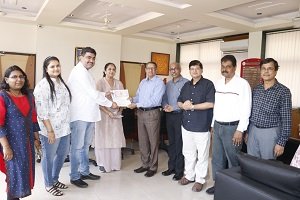ICAR-CIFE achieves a breakthrough in captive broodstock development of peacock eel
The technology comprises captive broodstock development, induced breeding and larval rearing in captivity.
ICAR-Central Institute of Fisheries Education, Mumbai developed the compressive package of captive seed production of peacock eel. The technology comprises captive broodstock development, induced breeding and larval rearing in captivity. In captivity, Peacock eel attain sexual maturity at the size of 18-25 g which is obtained after one year of rearing. Mature oozing males and gravid females were noticed in the mid of June 2024. The technology was developed by a team of scientists: Dr. Prem Kumar, Dr. S. Munilkumar, Dr. Rupam Sharma, and Dr. K.N. Mohanta.
Macrognathus aral (Peacock eel) is a commercially important fish species of mastacembelidae family. It is an important food fish of North-East India, Bihar and Jharkhand. Due to consumer demands and high nutritional value, it fetches a high market price between Rs. 500-600/kg. It also has very high ornamental value due to its attractive colour pattern, body shape and playful behaviour.
During the first week of July 2024, female fish (average body weight, 22 g) having the mean oocyte diameter of 1.45 mm and oozing males (average body weight, 14 g) in sex ratio of 2:1 (Male: Female) were selected and administered with an inducing hormone (a combination of LHRHa and domperidone) at the dose of 200 µl to female and half the dose to males. After an 18 h of average latency period, spawning was observed. The estimated functional fecundity of a female was around 3500. Fertilised eggs of Peacock eel were greenish, spherical, and adhesive in nature. The root of the Pistia plant was used as a substrate for the sticky eggs of the Peacock eel. Estimated fertilization and hatching rate were 45 and 20 per cent, respectively.
The larvae hatched out after an incubation period of 18 h at 28 0C water temperature. The newly hatched larvae measured from 1.65 to 1.85 mm with a large oval-shaped yolk sac. During nursery rearing, newly hatched larvae were transferred to outdoor tanks having floated aquatic plants (Pistia) as hideouts. The yolk sac was utilised after five days post-hatching (dph). Exogenous feeding was initiated after five dph with Artemia nauplii. which continued for 30 days. Weaning on a micro-particulate diet was started at 30 dph. Fry produced are being reared in outdoor tanks.
The technology comprises captive broodstock development, induced



